
The Cort Adeler House is a historic property located at Strandgade 22 in the Christianshavn neighbourhood of Copenhagen, Denmark. It takes its name from Admiral Cort Adeler who lived there for the last seven years of his life in the 17th century.
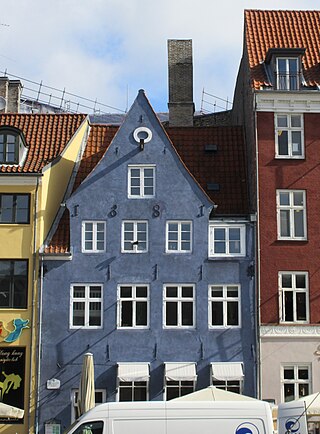
Nyhavn 9 is a historic townhouse overlooking the Nyhavn Canal in central Copenhagen, Denmark. It dates back to the 17th century and is one of few buildings along the canal that was not heightened in the 19th century. The building was listed on the Danish Registry of Protected Buildings and Places in 1918. It houses a restaurant in the ground floor.

Nyhavn 13 is a historic townhouse overlooking the Nyhavn Canal in central Copenhagen, Denmark. With roots dating back to the late 17th century, it owes its current appearance to a heightening of the building with two floors in 1842. Notable former residents include the businessman Abraham Marcus Hirschsprung and the painter and educator Wilhelm Kyhn. The building was listed in the Danish registry of protected buildings and places in 1945.

Store Kannikestræde 8 is a historic building in the Old Town of Copenhagen, Denmark. It was listed on the Danish registry of protected buildings and places in 1945. It has been in use as the parish house of Trinitatis Parish since 1890. Notable former residents include the historian Rasmus Nyerupm illustrator Peter Christian Klæstrup and the architect and urban planner Conrad Seidelin.
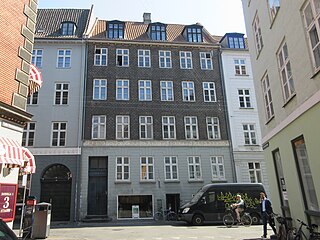
Skindergade 21 is a Neoclassical property situated on Skindergade, opposite Lille Kannikestræde, in the Old Town of Copenhagen, Denmark. It was listed in the Danish registry of protected buildings and places in 1964. Former residents include architect Michael Gottlieb Bindesbøll, poet Henrik Hertz, painter Heinrich Hansen and politician Carl Theodor Zahle.

Nikolaj Plads 32, also known as Sankt Nicolai Hus, is a property situated on the west side of Nikolaj Plads in Copenhagen, Denmark. It was, like most of the other buildings in the area, constructed as part of the rebuilding of the city following the Copenhagen Fire of 1795. It was listed in the Danish registry of protected buildings and places in 1945. Former residents include the theatrical scenic painter Christian Ferdinand Christensen.

Skindergade 6 is an 18th-century property situated on Skindergade, off the shopping street Købmagergade, in the Old Town of Copenhagen, Denmark. It was listed in the Danish registry of protected buildings and places in 1950. Former residents include the later Governor-General of the Danish West Indies Peter von Scholten, composer Hardenack Otto Conrad Zinck, linguist Rasmus Rask and clockmaker and politician Henrik Kyhl. Skindhuset, a retailer of leather products, is based in the building.

Skindergade 8 is a timber framed property situated on Skindergade, off the shopping street Købmagergade, in the Old Town of Copenhagen, Denmark. Constructed in 1733 as part of the rebuilding of the city following the Copenhagen Fire of 1728, it is one of the oldest buildings in the street. It was listed in the Danish registry of protected buildings and places in 1950.
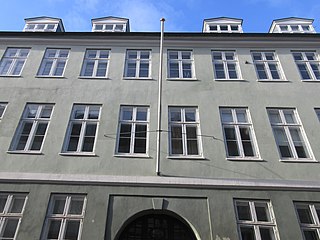
Brolæggerstræde 6 is a Neoclassical property situated in the Old Town of Copenhagen, Denmark. It was listed in the Danish registry of protected buildings and places in 1950. Former residents include the later bishop Jacob Peter Mynster and the politician Balthazar Christensen.
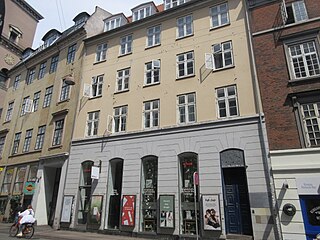
Nørregade 4 is an early 19th-century property situated in Nørregade, between Frue Plads and Gammeltorv, in the Old Town of Copenhagen, Denmark. The building was listed in the Danish registry of protected buildings and places in 1945.

Kringlegangen is a passageway linking the square Gråbrødretorv with the street Valkendorfsgade in the Old Town of Copenhagen, Denmark. A bakery was operated on the site from before 1787 until at least the 1910s. The present building complex was constructed in 1856-1857 for master joiner Carl Heinrich Winther. The passageway was not opened to the public until 1975. The name Kringlegangen was inspired by a gilded kringle above the entrance from Gråbrødretorv as well as to the twisting and turning course of the passageway. The entire building complex was listed in the Danish registry of protected buildings and places in 1945.
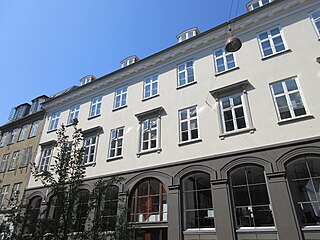
Skindergade 38/Dyrkøb 5 is a four-winged complex of 19th-century buildings with a nine-bays-long facade on Skindergade and a 10-bays-long facade on Dyrkøb, opposite the Church of Our Lady, in the Old Town of Copenhagen, Denmark. The two buildings fronting the streets were listed in the Danish registry of protected buildings and places in 1951. The two side wings—which attach them to each other along each their side of a central courtyard—are not part of the heritage listing. From October 1852 until his death three years later, Søren Kierkegaard was a lodger in the apartment on the first floor. Other notable former residents include the politicians Janus Lauritz Andreas Kolderup-Rosenvinge, Orla Lehmann and Valdemar Rudolph von Raasløff.

Skindergade 32/Fiolstræde 2 is a Neoclassical apartment building situated at the acute corner of Skindergade and Fiolstræde in the Old Town of Copenhagen, Denmark, designed and constructed by master mason Thomas Blom in 1837–38as his last independent work. He went with a somewhat outdated Neoclassical style, undoubtedly to make the building blend in with Christian Frederik Hansen's Trøstens Boliger, Church of Our Lady and Metropolitan School on three adjacent sites. The building was listed in the Danish registry of protected buuildings and places in 1945. Notable former residents include the mathematician Christian Ramus, judge and later professor of law at the University of Copenhagen Tage Algreen-Ussing, lawyer Lars Christian Larsen, director of the Zealand Railway Company Viggo Rothe and bookseller and publisher G.E.C. Gad.

Fiolstræde 18 is a half-timbered building situated at the corner of Fiolstræde and Krystalgade in the Old Town of Copenhagen, Denmark. It was constructed in 1734 as part of the bebuilding of the city following the Copenhagen Fire of 1728. It was listed in the Danish registry of protected buildings and places in 1939.

Rosengården 13 is a mid 19th-century property situated in the street Rosengården, between Kultorvet and the shopping street Strøget, in the Old Town of Copenhagen, Denmark. The building was listed in the Danish registry of protected buildings and places in 1964. The neighboring building at Rosengården 5 was also constructed for Culmsee.

Store Kannikestræde 6 is an 18th-century building situated in Store Kannikestræde in the Old Town of Copenhagen, Denmark. It was constructed in the second half of the 1730s as part of the rebuilding of the city following the Copenhagen Fire of 1728 and later heightened with one storey in the 1790s. It was listed in the Danish registry of protected buildings and places in 1945. Notable former residents include the antiquarian bookdealer Herman H. J. Lynge and publisher and editor Gottlieb Siesbye.

Skindergade 22 is a Neoclassical building situated at the corner of Skindergade and Lille Kannikestræde in the Old Town of Copenhagen, Denmark. It was listed in the Danish registry of protected buildings and places in 1979. Jens Andersen Hansen, publisher of the newspaper Almuevennen and a member of the Danish Constituent Assembly, was a resident of the building in around 1849.
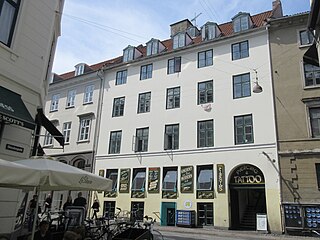
Skindergade 36/Dyrkøb 3 is a Neoclassical building complex situated close to Gammeltorv in the Old Town of Copenhagen, Denmark. It consists of a five-bays-wide, four-storey building in Skindergade and another five-bays-wide, four-storey building in Dyrkøb as well as a side wing which connects the two buildings along the west side of a central courtyard. The Dyrkøb building fronts the south side of the Church of Our Lady. N. J. Frænckels Stiftelse, a private senior citizens home administrated by the Hewish congregation, was located in the buuilding from 1899 until 1961. The building complex was listed in the Danish registry of protected buildings and places in 1945. Notable former residents include the painter Niels Simonsen, musician in the Royal Danish Orchestra H. S. Paulli (1810–1891) and theologian and translator Edvard Lembcke (1815–1897).

Fiolstræde 29 is a Neoclassical building situated on the shopping street Fiolstræde, roughly opposite Rosengården, in the Old Town of Copenhagen, Denmark. It was constructed by master carpenter Johan Christoffer Wahl as part of the rebuilding of the city following the British bombardment of Copenhagen in 1807. The building was listed on the Danish registry of protected buildings and places in 1951.

Kvæsthusgade 1/Nyhavn 69 is a three-storey building situated at the corner of Nyhavn and Kvæsthusgade. A memorial featuring a bust of a diver wearing a diving helmet commemorates that Em. Z. Svitzer's Bjernings-Enterprise, a salvage company founded by Emil Zeuthen Svitzer back in 1833, was once headquartered in the building. Notable former residents include the actress Magda von Dolcke.























